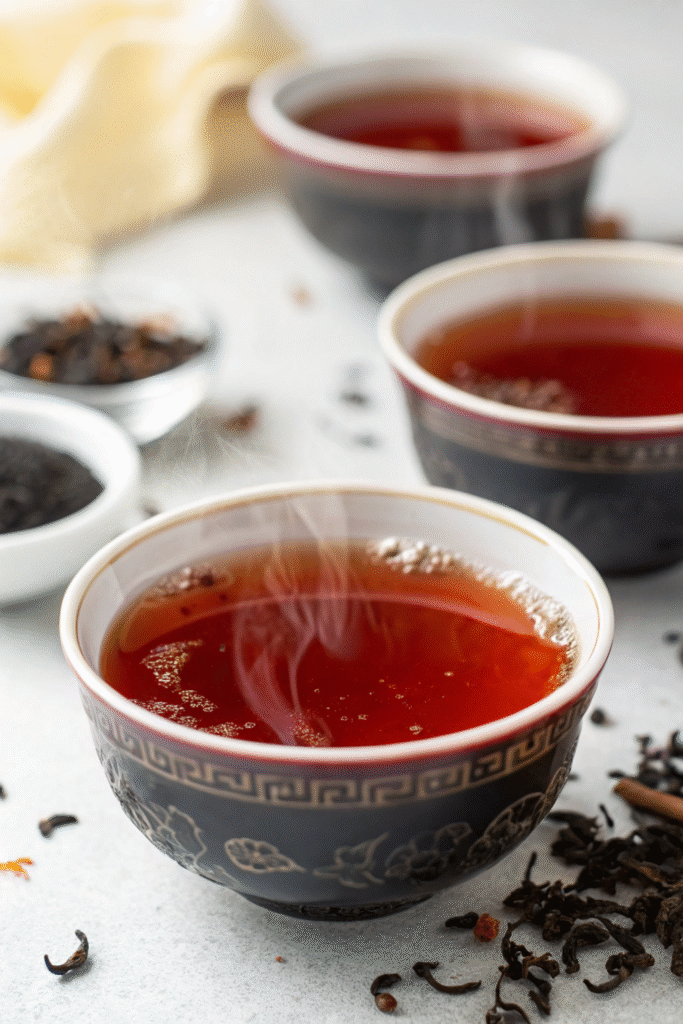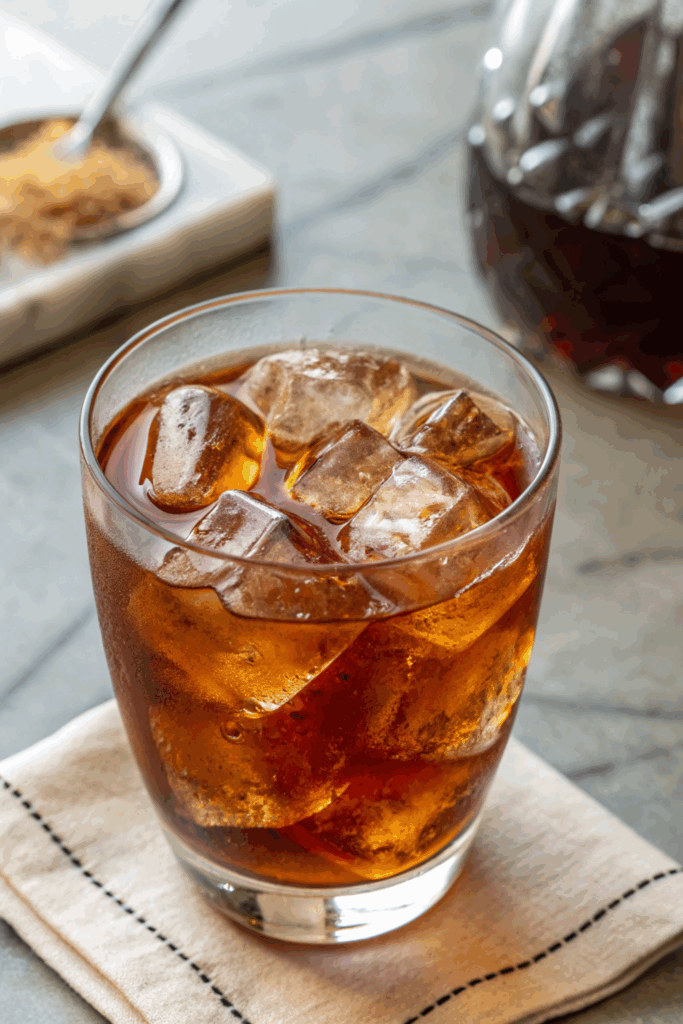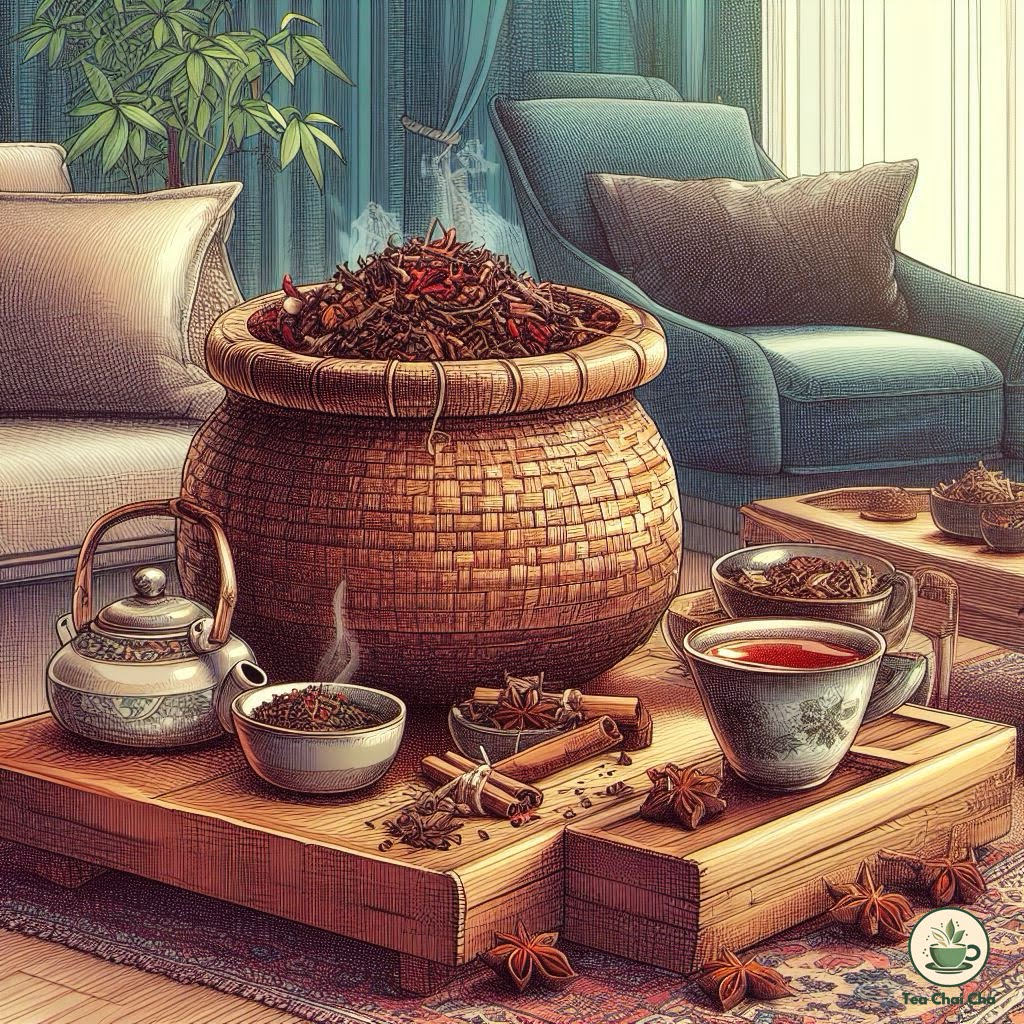A place high up in the Sri Lankan mountains, where the air is cool and crisp, that’s where they grow Ceylon tea. The air is kind of misty and damp, and it’s not too hot, just perfect.
The weather is like nature’s spa day for the tea leaves. They get plenty of rain and the air is just a bit humid.
Plants get a gentle misting all the time. And guess what? This makes the tea taste amazing!
Ceylon tea ends up having this zesty smell, like when you peel an orange or a grapefruit.
Now you must be wanting to visit tea fields in Sri Lanka. But let me help you brew a cup of this fruity Sri Lankan tea and enjoy its zesty aroma in your house!

What Is Ceylon Tea?
Ceylon tea comes from Sri Lanka. It’s a tropical island in South Asia with lush green hills and misty mornings.
At that time, Sri Lanka was known as Ceylon. That’s where the tea got its name.
The island’s perfect climate and high altitudes create the ideal conditions for growing some of the finest tea leaves in the world.
History
Now, let me take you back in time a bit. The story of Ceylon tea dates back to the 19th century when a British man named James Taylor planted the very first tea plant in Sri Lanka in the 1860s.
He had this brilliant idea of replacing coffee crops, which were hit hard by a disease, with tea plants. Little did he know that this decision would lead to the birth of a tea legacy!
James Taylor began experimenting and refining the tea production process, and soon enough, Ceylon tea gained a reputation for its exceptional quality and unique flavor.
The British were so impressed that they started exporting it all around the world. The tea estates in Sri Lanka grew, and the aroma of Ceylon tea began to enchant tea lovers everywhere.
What You Need to Make Ceylon Tea
Making a delicious cup of Ceylon tea is a simple pleasure that can be enjoyed any time of the day. To ensure you brew the perfect cup, here’s a list of essential items you’ll need:
1. Quality Ceylon Tea Leaves: Start with the star ingredient – Ceylon tea leaves.
Look for loose-leaf Ceylon tea, as it offers better flavor and aroma compared to tea bags.
Opt for a reputable brand or source to ensure you’re getting the authentic Ceylon tea experience.
2. Fresh Water: Good tea begins with good water. Use fresh, cold water from the tap or a clean source.
If your tap water has a strong taste or odor, consider using filtered water for a cleaner taste in your tea.
3. Teapot or Teacup: Choose a teapot or teacup that suits your preference.
A teapot is great for brewing larger quantities, while a teacup with an infuser is ideal for single servings.
Make sure the teapot or cup is clean before use to avoid any unwanted flavors.
4. Tea Infuser or Strainer: If you’re using loose-leaf tea, a tea infuser or strainer is essential to prevent tea leaves from floating around in your cup.
5. Boiling Device: You’ll need a way to heat your water. A kettle or stovetop pot works well.
If using a microwave, make sure your teapot or cup is microwave-safe.
6. Timer: A simple kitchen timer or the timer on your phone will help you keep track of the brewing time. This is crucial for achieving the desired flavor strength.
7. Optional Additions: Ceylon tea is often enjoyed plain, but you can customize your cuppa with optional additions like milk, sugar, honey, or lemon.
These additions can complement the tea’s flavor based on your taste preferences.
8. Serving Accessories: Prepare your tea-drinking experience with essentials like teacups, saucers, teaspoons, and napkins.
These add a touch of elegance to your tea ritual.

How to Make Ceylon Tea
To make a perfect cup of Ceylon tea, you’ll need to start with the right ingredients as mentioned above and follow a few simple steps.
Step 1: Selecting High-Quality Ceylon Tea Leaves
The foundation of a delicious cup of Ceylon tea begins with selecting the right tea leaves.
Opt for loose-leaf Ceylon tea, as it allows the leaves to unfurl and release their full flavor.
Look for leaves with a vibrant color and avoid any that appear dull or dusty.
When choosing between various types of Ceylon tea, such as black, green, or white, consider your flavor preferences.
Black Ceylon tea is robust and well-rounded, while green Ceylon tea offers a lighter and more delicate taste.
Step 2: Choosing Fresh or Filtered Water
The quality of the water you use plays a crucial role in brewing the perfect cup of Ceylon tea.
Opt for fresh, cold water that has not been previously boiled.
Avoid using water that has been sitting for an extended period, as it may affect the tea’s taste.
If possible, use filtered or bottled water to ensure the best flavor.
Step 3: Boiling Water to the Right Temperature
Different types of Ceylon tea require different water temperatures to bring out their distinct flavors.
For black Ceylon tea, bring water to a rolling boil and then let it cool for a moment before pouring it over the tea leaves.
Green Ceylon tea, on the other hand, should be brewed with water that has cooled slightly after boiling, around 175°F (80°C).
This prevents the tea from becoming bitter and maintains its delicate taste.
Step 4: Warming the Teapot
To ensure that the brewed tea stays at an optimal temperature during steeping, warming the teapot is essential. Here’s how I do it:
While the water is heating, pour a small amount of hot water into the teapot.
Gently swirl the water around, making sure to cover the entire inside surface of the teapot.
After a few seconds, pour out the warming water, leaving the teapot warm and ready for the tea leaves.
Step 5: Ceylon Tea Brewing and Steeping
Place the desired amount of Ceylon tea leaves into a teapot or infuser.
Use about 1 teaspoon of tea leaves per cup of water, adjusting according to your taste preferences.
Pour the hot water over the tea leaves and allow them to steep.
For black Ceylon tea, steep for 3-5 minutes, while green Ceylon tea should be steeped for 2-3 minutes.
Oversteeping can lead to a bitter taste, so keep an eye on the time.
Step 6: Give Your Ceylon Tea a Personal Touch
While Ceylon tea is flavorful on its own, you can enhance your experience with optional additives.
Consider adding a splash of milk or a touch of honey to your black Ceylon tea for a creamier and slightly sweet taste.
Green Ceylon tea pairs well with a slice of lemon or a hint of mint for a refreshing twist.
Step 7: Enjoying Your Cup of Ceylon Tea
Once your tea has steeped to perfection, pour it into your favorite teacup or mug.
Feel free to experiment with different steeping times and additives to find your personal favorite combination.
Here’s what I made, I like my ceylon iced 😉

Ceylon Tea Hot or Cold?
For those who savor the warmth of hot tea, consider trying Ceylon black tea (classic Ceylon tea recipe at the end).
These teas have a strong and robust character, making them an ideal choice for those cozy moments in the morning or during peaceful evenings.
If you prefer a milder flavor, the Ceylon orange pekoe tea might be more to your liking. It’s a well-balanced option that’s suited for everyday enjoyment.
If cold tea is more your style, you’re in for a treat.
Ceylon green tea is an excellent candidate for crafting refreshing iced tea.
Its slightly earthy and grassy notes take on a new life when chilled.
Additionally, if you’re seeking a dash of excitement, the world of flavored Ceylon teas awaits.
These teas, especially those infused with fruity goodness, make fantastic cold brews that will refreshen your taste buds.
Don’t forget, the method you use to prepare your tea plays a role in its taste.
When brewing hot tea, pay attention to the steeping time to achieve the right balance of flavors.
On the other hand, if you’re going for a cold brew, place the tea leaves in cold water in the fridge overnight.
This results in a smoother and less bitter taste compared to traditional hot brewing and then cooling.
How to Make Ceylon Iced Tea
Here’s a guide on how to make Ceylon Iced Tea using the cold brew method:
Ingredients You’ll Need
- 4-5 teaspoons of Loose Leaf Ceylon Tea
- 4 cups of Cold Water
- Ice Cubes
- Sweetener (sugar, honey, or your preferred choice)
- Lemon slices or mint leaves (optional, for added flavor)
Step-by-Step Guide
1. Choose Quality Ceylon Tea: Select a good-quality loose leaf Ceylon tea.
Opt for black, green, or flavored Ceylon tea based on your taste preferences.
2. Mix Tea and Cold Water: In a pitcher or jar, combine 4-5 teaspoons of loose leaf Ceylon tea with 4 cups of cold water.
You can adjust the tea quantity based on how strong you prefer your iced tea.
3. Infuse in the Refrigerator: Cover the pitcher or jar and place it in the refrigerator.
Allow the tea to steep in the cold water for about 8-12 hours.
This slow steeping process in cold water extracts the flavors gently without bitterness.
4. Strain and Sweeten: After the steeping time, remove the pitcher from the refrigerator.
Using a fine mesh strainer or tea infuser, strain out the tea leaves.
You’ll be left with a smooth, concentrated tea.
5. Sweeten to Taste: While the tea is still cold, add your preferred sweetener to the concentrated tea.
Start with around 1-2 tablespoons of sugar or honey, and adjust according to your taste.
Stir until the sweetener dissolves completely.
6. Prepare the Iced Tea: Fill glasses with ice cubes and pour the cold brewed Ceylon tea over the ice.
It yields four servings.
If desired, add lemon slices or mint leaves for an extra layer of flavor and freshness.
7. Enjoy Your Ceylon Iced Tea: Give the iced tea a gentle stir to combine the flavors.
Find a cozy spot, sit back, and savor the delightful taste of your homemade Ceylon Cold Brew Iced Tea.
Factors Affecting Ceylon Tea Taste
Ceylon tea is known for its distinctive taste, and a few key factors contribute to its flavor:
Elevation and Climate
The altitude at which tea plants are grown plays a big role.
Teas grown at higher elevations tend to have a brisk and lively flavor, while teas from lower elevations may be milder.
The climate in different regions can also influence the taste, so you might notice variations based on whether the tea comes from a cooler or warmer area.
Processing Techniques
How the tea leaves are processed has a big impact on the flavor.
Ceylon tea can be categorized into different types such as black, green, white, and oolong.
Each type goes through unique processing steps that bring out distinct flavors.
For instance, black Ceylon teas often have a bold and robust taste, while green Ceylon teas tend to be more delicate and grassy.

Leaf Grade and Size
The size and quality of the tea leaves matter.
Whole leaves or larger leaf particles might offer a smoother and more nuanced flavor.
On the other hand, smaller leaf particles can create a stronger, more brisk taste.
Pay attention to the leaf grade mentioned on the packaging to get an idea of what to expect.
Terroir
Just like wine, tea can exhibit flavors influenced by its terroir – the unique combination of soil, climate, and geography where it’s grown.
Ceylon tea from different regions within Sri Lanka can showcase diverse flavor profiles due to variations in terroir.
Plucking and Harvesting
The timing of tea leaf plucking impacts the flavor too.
Younger leaves tend to produce a milder and more delicate taste, while older leaves might give a stronger flavor.
“First flush” teas, harvested in the spring, usually have a fresh and bright character, while “second flush” teas from later in the year can be more robust.
Blend and Flavoring
Some Ceylon teas are blended with other ingredients like fruits, flowers, or spices.
These additions can significantly alter the flavor.
If you’re looking for something with a unique twist, you might enjoy trying a flavored Ceylon tea.
Brewing Method
Finally, how you prepare the tea matters.
The water temperature, steeping time, and even the teapot or teacup you use can affect the final taste.
Experiment with different brewing methods to find the balance that suits your taste preferences.
Remember, the flavor of Ceylon tea can vary widely based on these factors.
Tip!
- If you prefer a brisk and bold cup, go for teas from higher elevations or black teas.
- If you’re into milder and more delicate flavors, opt for teas from lower elevations or green/white teas.
Feel free to explore and find the Ceylon tea that matches your taste buds perfectly!
How to Make Ceylon Tea Taste Good
There are a bunch of ways to enjoy Ceylon tea with different flavors and types of drinks. And I’m here to help you choose the right things to create a tasty tea experience.
Add a Twist with Citrus
Squeezing a bit of lemon or orange into your Ceylon tea can give it a zesty kick.
Citrus flavors complement the rich notes of Ceylon tea and add a refreshing twist.
Spice it Up
If you enjoy a bit of warmth, try adding a cinnamon stick or a pinch of ground cinnamon to your tea.
This adds a cozy flavor that’s perfect for chilly days.
Honey Sweetness
A spoonful of honey can transform your Ceylon tea into a soothing and naturally sweet treat.
It balances the tea’s astringency and creates a lovely harmony of flavors.
Creamy Comfort
If you’re into creamier drinks, consider adding a splash of milk or a dollop of condensed milk to your tea.
This creates a velvety texture and can mellow out the tea’s strong character.
Ceylon Chai
Spice lovers, unite! Create a Ceylon chai by simmering Ceylon tea with spices like cardamom, ginger, and cloves.
Add milk and a touch of sweetener for a spiced tea experience.
Fruity Fusion
Infuse your Ceylon tea with fruit flavors. Add slices of peach, strawberries, or even a handful of berries to your tea while it’s steeping.
This adds a natural sweetness and a burst of fruity aroma.
Herbal Harmony
Experiment with herbal blends. Mix Ceylon tea with herbs like mint, chamomile, or lavender for a calming and aromatic infusion.
Ceylon Tea Mocktails
Get creative with mocktail recipes.
Mix brewed Ceylon tea with fruit juices like pineapple or cranberry, add a splash of soda water, and garnish with mint leaves for a delightful non-alcoholic beverage.
Ceylon Tea Food Pairings
Ceylon tea has a range of flavors, from light and delicate to bold and robust. You can pair this tea with a range of foods.
Here are some simple recommendations:
Light & Delicate Ceylon Tea
When you have a light and delicate Ceylon tea, like a White Ceylon or a Uva Green tea, pair it with subtle flavors.
A great choice would be pairing it with fresh fruits like sliced peaches or strawberries.
The gentle tea won’t overpower the delicate flavors of the fruits, creating a balanced and refreshing experience.
Medium-bodied Ceylon Tea
If you’re enjoying a medium-bodied Ceylon tea, such as a Dimbulla or Nuwara Eliya Black tea, consider pairing it with baked goods.
A classic combination is enjoying a cup of Ceylon tea with a piece of buttery shortbread or a slice of lemon cake.
The tea’s medium strength complements the richness of these treats.
Bold & Robust Ceylon Tea
For bold and robust Ceylon teas like Assam tea or a hearty Ceylon BOP (Broken Orange Pekoe), opt for stronger flavors.
Think about pairing it with savory items like cheese and charcuterie.
A bite of aged cheddar or a slice of prosciutto can stand up to the tea’s robust character.
Chai-spiced Ceylon Tea
If you’re trying a spiced Ceylon tea, like a Ceylon Chai, consider pairing it with warm, comforting foods.
A delicious match would be a slice of pumpkin pie or a spiced muffin.
The tea’s spices and warmth will harmonize with the cozy flavors of the baked goods.
Earl Grey Ceylon Tea
When enjoying an Earl Grey Ceylon tea, with its distinctive bergamot flavor, try pairing it with citrusy desserts.
A zesty lemon tart or orange-infused biscotti can complement the citrus notes in the tea, creating a delightful contrast.

Ceylon Thai Iced Tea
Brew a strong batch of Ceylon tea and let it cool.
Then, mix it with condensed milk and a touch of evaporated milk for that authentic Thai iced tea flavor.
Pour it over ice and enjoy the creamy, sweet, and slightly spiced goodness. It’s a perfect balance of Ceylon tea’s character with Thai-inspired sweetness.
When to Drink Ceylon Tea
The best thing about Ceylon tea is its versatility, so you can enjoy it at various times throughout the day.
Morning Delight
Starting your day with a cup of Ceylon tea is a great idea.
Its vibrant flavors and moderate caffeine content can give you the gentle energy boost you need to kick-start your morning routine.
Afternoon Elegance
The afternoon is another wonderful time to savor Ceylon tea.
Whether you’re taking a break from work or enjoying a leisurely afternoon, the smooth taste of Ceylon tea can be your perfect companion.
Teatime Bliss
If you’re a fan of traditional teatime, Ceylon tea fits right in.
Its brisk and full-bodied taste pairs excellently with treats like scones, pastries, or finger sandwiches.
Invite friends over or have a quiet moment by yourself – either way, it’s a delightful choice.
Relaxation Mode
As the day winds down, consider winding down with a cup of decaffeinated Ceylon tea.
It’s a soothing option that can help you relax without worrying about caffeine keeping you up at night.
Related
Ceylon Tea Recipe
Recipe by Tania FaysalCuisine: Sri Lankan2
servings3
minutes10
minutes16
kcalDiscover the warmth of Sri Lanka in a cup with our traditional Ceylon Tea recipe - perfect for two tea enthusiasts!
Ingredients
2 tsp of pure Ceylon black tea leaves
2 cups of water
2 tsp of sugar (or to taste)
2 slices of ginger (optional)
2 cardamom pods (optional)
Directions
- Steep the tea: Bring the water to a boil at 194°F (90°C). Add the Ceylon black tea leaves and let it steep for 2-3 minutes.
- Add the optional spices: If you're opting for a spiced tea, add the ginger slices and cardamom pods after steeping the tea. Allow it to simmer for another minute.
- Sweeten your brew: Stir in the sugar according to your taste and let the tea simmer for a minute more.
- Strain and serve: Pour your freshly brewed Ceylon tea through a strainer and into your favorite teacups. Serve hot and enjoy!
Frequently Asked Questions (FAQs)
What does Ceylon tea taste like?
Ceylon tea offers a diverse range of flavors, but generally, it’s known for its bright and brisk taste.
Depending on the specific region it’s grown in, Ceylon tea can exhibit citrusy, fruity, and sometimes even floral notes.
It might also have a slightly astringent or dry quality, which is a common characteristic of black teas.
Does Ceylon tea have caffeine?
Yes, Ceylon tea does contain caffeine. It’s a type of black tea, which naturally contains caffeine.
The caffeine content can vary depending on factors like the tea’s processing and brewing time. But in general, Ceylon tea has a moderate caffeine level.
Is Ceylon a real tea?
Absolutely, Ceylon tea is indeed a real type of tea. Ceylon tea comes from the Camellia sinensis tea plant.
How many calories in Ceylon tea?
Generally, plain brewed Ceylon tea contains very few calories, typically around 2 calories per 8-ounce cup.
The calorie count might increase slightly if you add milk, sugar, honey, or other flavorings to your tea.
Do you put milk in Ceylon tea?
Yes, you can definitely put milk in Ceylon tea if you enjoy it that way!
Adding milk to Ceylon tea is a common practice, especially in countries where milk tea is a popular beverage.
The milk can help mellow out the tea’s strong flavors and create a creamy and comforting texture.


